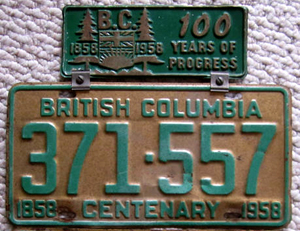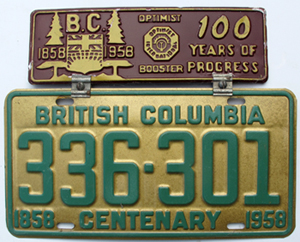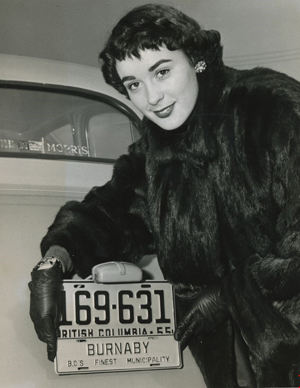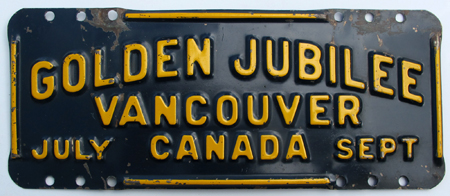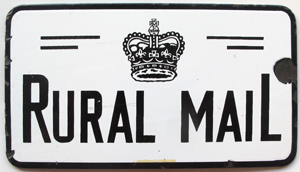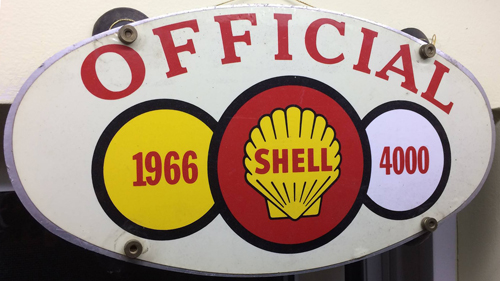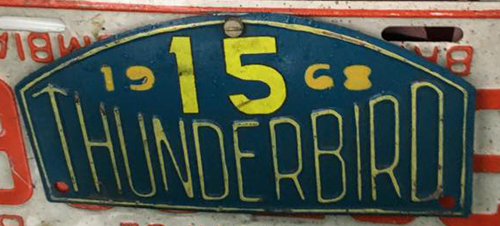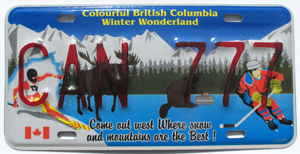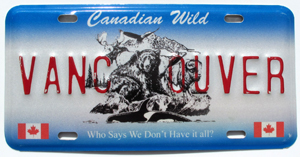|
British
Columbia "Booster" License Plates

|
| Common in the mid-1950s, booster plates that effectively allowed motorists to broadcast where they lived, were used as fund rasining tools by various local groups. |
| The image at left captures this trend, with the caption used in the local paper explaining the purpose of the plate: "Burnaby's Beauties are being ably promoted by the Junior Chamber of Commerce in offering these legend plates that attach to car licenses. Above is Miss Burnaby and Miss PNE, pretty Nancy Hansen, who joins in the publicity by showing how it is done. The $1 plates are sold at serivce stations, with proceeds for JCC Burnaby projects. Photo by Bob Atlee." |
| In an interesting aside, another description of this same photo refers to the booster plate as being a "legend plate". |
|
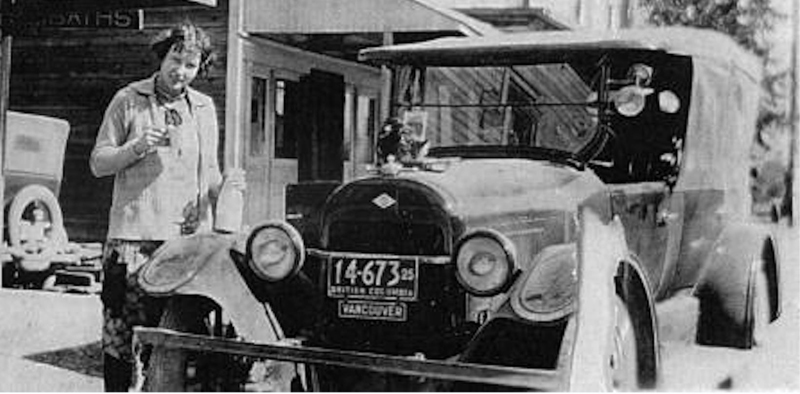
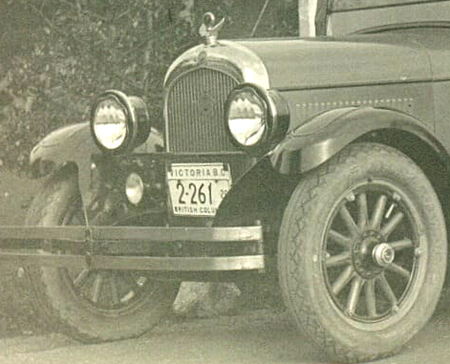 |
 |
On September 11, 1922, the Victoria and Island Publicity Bureau announced that it had manufactured 1,000 booster plates bearing trhe slogan "Victoria B.C." that could be attached to regular license plates. The cost of the plates was $0.25 and they were to be marketed to local tourist. The Bureau announced that it had become "quite a common practice now for motorists to advertise their home towns by carrying such a name plate on their car.".
It is assumed that both the Victoria and Vancouver boosters were made by J.R. Tacey & Son, but only the Vancouver plate bears this inscription. |
|
Shown above is a Vancouver booster (circa 1933) proclaiming the City to be "Canada's Pacific Gateway". |
| Community Booster Plates |
|
|
|
|
|
|
|
|
|
|
|
|
|
|
|
|

Summerland: The Heart of the Okanagan
|

Oliver: In the "Beuatiful" (sic) Okanagan
|
|

Vancouver: Grey Cup City in 55
|

Abbotsford: Hub of the Fraser Valley
|

Whalley: Heart of North Surrey
|
| Provincial Centennials |
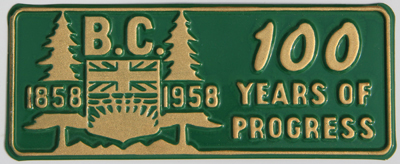
1958 Centennial: "100 Years of Progress" |

1958 Centennial: "100 Years of Progress" (Optimist Version) |

1971 Centennial: Confederation with Canada (1871-1971) |
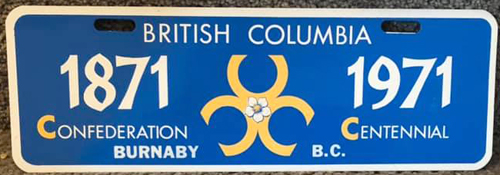
1971 Centennial Booster - Burnaby Variant |
| Centennial Boosters |
To further mark the Centennial, the official Centennial Committee of British Columbia authorised the production of a booster plate that could be attached to a radio antenna or license plate. This is the smaller gold-on-green plate shown below (left) and which was manufactured by the Superior Stamp & Stencil Company of Vancouver. The cost of the booster in 1958 is believed to have been around $2.00 (a known surviving envelope has a price tag of $1.79 on it). |
The local chapter of the BC Optimist's also produced a variant of these boosters which employed a different background colour (dark purple?) and were slightly longer in order to accommodate the inclusion of the Optimist's own logo. |
| Forestry |
|

BC Forest Service |
|
A booster plate afixed to vehicles delivering mail in the rural areas of the province, it is thought that this particular porcelain plate was used some time in the 1940s.
|
| British Columbia International Trade Fair (BCITF) Car Rally |
 |
In 1961, the British Columbia International Trade Fair (BCITF) organised a Car Rally that started in Montreal on the morning on Sunday April 30, 1961 and ended the following Saturday May 6, 1961, in Vancouver (with stops in Toronto, Thunder Bay, Winnipeg, Regina, Calgary and Penticton).
All participants in the race were provided a rally plate to display on the front of their cars. As the Shell Oil Company of Canada was a major sponsor, its logo was included in the design. By 1967, the plate had been replaced by a decal or magnet.
|
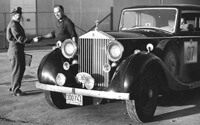 |
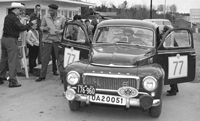 |
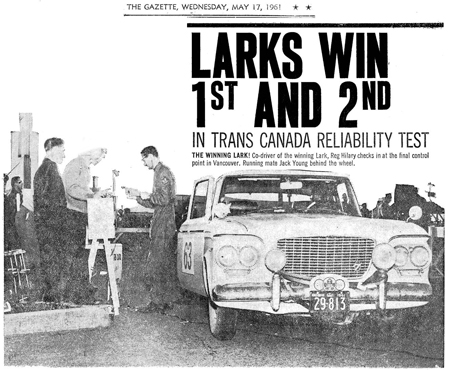 |
This all Canadian route covered 3,800 miles (billed in one newspaper account as the longest rally in the world) and was a formal event on the 1961 International Rally Calendar (having been sanctioned by the Royal Automobile Club and the Federation Internationale de l'Automobile).
71 trophies and $5,000 in prize money was up for grabs and approximately 106 cars would leave Montreal on race day. In the end, Jack Young and Reginald Hillary of Toronto won the rally in their Studebaker-Packard Lark.
All information on this page, other than the photo of the Rally Plate, is courtesy of "The Shell 4000 and BC Trans-Canada Rally History Project".
|
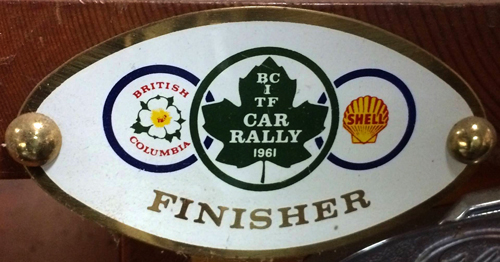 |
|
| Thunderbird Rally |
|
 |
The Thunderbird Rally is a winter driving adventure through snow and ice covered back roads in the British Columbia interior. Started in 1957, the Rally was part of the Canadian Rally Championship from the mid 1960's to the early 1970's, when the format of the series changed from Time Speed Distance (TSD) to stage (performance) events. The Rally was resurrected by the UBC Sports Car Club in its original format in 1987, and celebrated its 50th anniversary in 2007 with a booster plate manufactured by Astrographic.
|
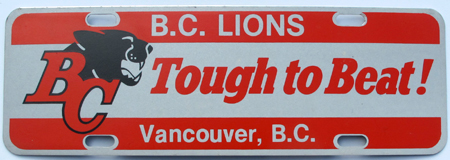 BC Lions of the Canadian Football League (CFL). BC Lions of the Canadian Football League (CFL).
|
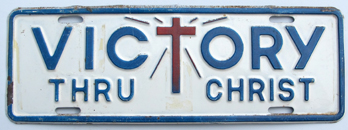
Victory Thru Christ
|
| |
|
|
|
| A series of booster plates produced by Astrographic for sale in "souvenir" shops throughout the province (but principally in Vancouver's Gas Town and Victoria's Government Street). I can't even begin to describe the design... |
|
The 1874 "March West" by the RCMP was an arduous trek from Fort Dufferin to two points in the North West Territories, Fort Macleod and Fort Edmonton. The police force had been commissioned by the government of the day to take law and order to the Canadian west. The plate at left comes out of the Astrographic collection and we wonder if it was ever issued given the wrong dates on display?!?! The original trek was in 1874 and the anniversary trek was held in 1999! Whoops! Granted, the force itself was created in 1873, and 1998 would have been its 125th anniversary, but that it not what the plate seem to be commemorating.
|
 In 1986, the Victoria Chapter of the Early Ford V8 Club applied and were selected to host a Western National Meet and named it "Fords and Flowers". In 1986, the Victoria Chapter of the Early Ford V8 Club applied and were selected to host a Western National Meet and named it "Fords and Flowers".
There were approximately 460 Ford product cars and trucks parked all around the Victoria harbour, causeway and Legislative Assembly grounds for the event and, one assumes, displaying the type of event license plate as shown in the image at right. It is believed that the plates were made by Astrographic and display their classic die type.
|
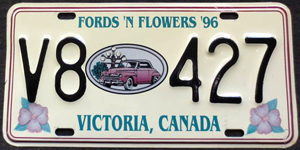 In 1996, the Victoria Chapter applied and were selected to host another Western National Meet, which they named (again) "Fords 'N' Flowers". In 1996, the Victoria Chapter applied and were selected to host another Western National Meet, which they named (again) "Fords 'N' Flowers".
The venue for the car display in 1996 was Clover Point, a small peninsula on Dallas Road, with the ocean surrounding the vehicles and the Olympic Mountains to the south as a backdrop.
Approximately 480 cars attended from all over North America and the logo this time around was, not surprisingly, a 1946 Ford convertible, again with a Victoria lamppost and flower baskets. It is believed that the plates were made by Astrographic and display their classic die type.
|

© Copyright Christopher John
Garrish. All rights reserved.
|






